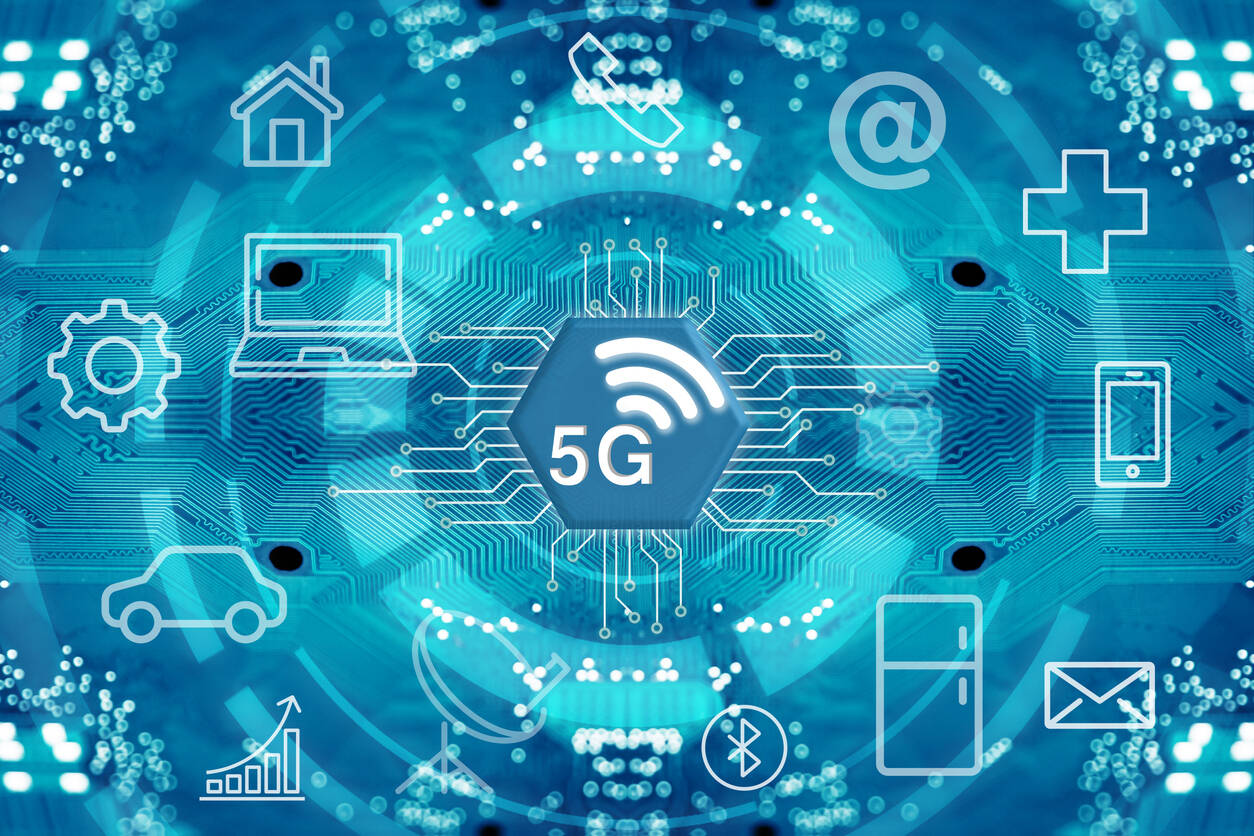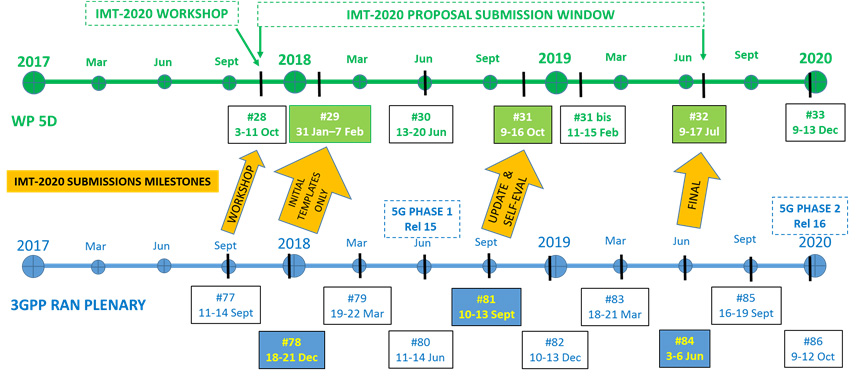Month: October 2019
Gartner: 5G IoT endpoints to triple between 2020 and 2021; Surveillance cameras to be largest market over next 3 years
Executive Summary:
After 3GPP release 16 has been completed and included in IMT 2020 RIT/SRIT, 5G networks will offer ultra-reliable, ultra-low-latency and high-bandwidth capabilities. That will open up new enterprise market opportunities for communications service providers/wireless network operators. Therefore, understanding the future market is key to an effective strategy. Gartner Inc. says that IoT use cases like surveillance cameras and connected cars will offer the biggest markets for 5G IoT.
| Segment | 2020
Volume |
2020
Market Share (%) |
2023
Volume |
2023
Market Share (%) |
| Connected cars — embedded (consumer and commercial) |
393 |
11 |
19,087 |
39 |
|
Outdoor surveillance cameras |
2,482 |
70 |
15,762 |
32 |
|
Fleet telematics devices |
135 |
4 |
5,146 |
11 |
|
In-vehicle toll devices |
50 |
1 |
1,552 |
3 |
|
Emergency services |
61 |
2 |
1,181 |
2 |
|
Others |
400 |
11 |
5,863 |
12 |
|
Total |
3,522 |
100 |
48,590 |
100 |
Due to rounding, figures may not add up precisely to the totals shown
Source: Gartner (October 2019)
Connected Cars Will Offer the Biggest Opportunity for 5G IoT in the Long Term:
In 2023, the automotive industry will become the largest market opportunity for 5G IoT solutions. It will represent 53% of the overall 5G IoT endpoint opportunity in that year.
Within the automotive sector, embedded connected-car modules are the major use case for 5G. Embedded endpoints in connected cars for commercial and consumer markets will represent an installed base of 19.1 million units out of a total of 25.9 million 5G endpoints in the automotive sector in 2023.
“The addressable market for embedded 5G connections in connected cars is growing faster than the overall growth in the 5G IoT sector,” said Ms. Baghdassarian. “Commercial and consumer connected-car embedded 5G endpoints will represent 11% of all 5G endpoints installed in 2020, and this figure will reach 39% by the end of 2023.”
In addition, the share of 5G-connected cars actively connected to a 5G service will grow from 15% in 2020 to 74% in 2023. This figure will reach 94% in 2028, when 5G technology will be used for Cellular V2X communications that enable messages to be sent and received within vehicles and between vehicles, infrastructure, pedestrians, cyclists and more. Ultimately, connected cars actively connected to a 5G service will help keep traffic moving and improve road safety.
“As the automotive industry will be the largest sector for IoT endpoints and 5G IoT use cases in the long term, we recommend that CSPs that want to be relevant in the 5G IoT market put this industry at the forefront of their investments. They should do this in terms of personnel who understand the sector and of partnerships that will move the market forward,” said Ms. Baghdassarian.
Other Analyst and Industry Opinions:
“The industrial IoT market is among the most fractured especially amongst the verticals like healthcare and automotive,” said Lee Doyle, principal analyst with Doyle Research. “Large companies such a Cisco, HP and IBM have been challenged to address it because it is so fractured. It’s not at all clear any one of them has the overall network architecture to handle it all.” Vendors need to show users on a case-by-case, application-by-application basis what works, Doyle said.
…………………………………………………………………………………………………………………………………………………………………………………………………………
“With 5G, you can put more video cameras up in a big facility to monitor where folks are going and what they’re doing. Then bring analytics into the picture to increase efficiency. Speed really matters when you’re adding that many cameras,” said Samsung Networks’ VP of Networks Strategy & Marketing Alok Shah.
Shah believes the most “magical” element of 5G for enterprise users is decreased latency (so does this author, but it won’t happen till 3GPP Release 16 is finalized). “Bringing latency down substantially allows the user to perform from a remote perspective much more. Robotics in factories can be manipulated without being there in person,” he elaborated.
In addition, with 5G, the number of IoT sensors that can be implemented can skyrocket. “It can go up to a million sensors around a facility, which is huge,” Shah stated. “It’s a combo of these different things. You don’t get all of this at once because different devices have different requirements, but network slicing will help with this,” Shah added.
……………………………………………………………………………………………………………………………………………………………………
Ericsson’s new 5G business potential report considers a set of “5G-enabled B2B use case clusters” as drivers of industrial 5G revenues. Among these use case clusters, it said “enhanced video services” represents the largest opportunity for telecoms providers in terms of value across industrial sectors, worth up to 17 per cent or $118 billion of the total value by 2030.
Ericsson said enterprise 5G services will drive up to $700 billion of new revenues in the period. However, the total market, of 5G services for industry will be worth more than twice that, it said. The $700 billion operators can go for corresponds to 47 per cent of the total 5G business-to-business (B2B) market to be served by ICT players. Network operators must extend their reach “beyond connectivity” and consider newer roles for their services and expertise within the B2B value chain, and “what use case clusters to address.” Operators must act urgently, Ericsson warned, if they are to capture new value from industrial transformation services, as revenues for existing airtime services will remain stagnant through to 2030.
The chart below superbly illustrates the dire dilemma of network operators- traffic increasing exponentially, revenues (measured by ARPU) decreasing!

Jan Karlsson, senior vice president and head of B2B digital services at Ericsson, said: “The journey to grow the 5G business starts now by building momentum and identifying 5G-enabled B2B opportunities.”
Ericsson looked at the following industrial sectors for its report: manufacturing, automotive, energy and utilities, public safety, healthcare, media and entertainment, public transport, financial services, retail, and agriculture.
Other use cases in the report, besides enhanced video, include real-time automation, connected vehicles, and augmented/virtual reality. The company said use case examples building up these ‘clusters’ include live streaming of events, real-time monitoring of distributed energy, and autonomous cars.
–>Please refer to my comment in box below this article for more on the Ericsson report.
……………………………………………………………………………………………………………………………………………………………………
“Clearly there is no single access technology out there that solves all the problems and challenges of networking especially in the industrial arena where customers have one of every type of communications device imaginable, but 5G and Wi-Fi 6 will deliver a whole bunch of new use cases and address many multi-access requirement challenges,” said Liz Centoni, senior vice president and general manager of Cisco’s Internet of Things Business Unit, in an interview with Network World.
“Many industrial IoT use cases mandate wide mobility, low latency, and mission-critical reliability, such as mobile-robot control in production automation and autonomous vehicles in open-pit mining. These use cases rely on wireless access at 50ms to 1ms latency and service reliability from 5 nines to 6 nines,” Centoni wrote in a recent blog about 5G.
“4G/LTE has attempted to address these use cases but has often failed due to unsatisfactory performance. 5G’s combination of ultra-reliable and low-latency connection will extend industrial IoT to unconquered spaces,” Centoni.
Cisco’s Scott Harrell, senior vice president and general manager of enterprise networking told Network World the company expects to see a lot of 5G being used in branches as a faster backup and bandwidth alternative to current 4G or LTE links. Keeping an enterprise’s branch and campus locations all connected to each other and the internet has traditionally fallen to wired technologies like T1/E1 and xDSL, Harrell said. Today, 4G is often used to quickly bring up sites or as a back-up link, but it’s seldom used as a primary link, due to bandwidth limitations and cost, Harrell said.
https://www.networkworld.com/article/3446457/cisco-pushes-5g-to-hasten-industrial-iot.html
https://blogs.cisco.com/news/how-5g-will-accelerate-industrial-iot
https://www.ericsson.com/assets/local/5g/the-5g-for-business-a-2030-compass-report-2019.pdf
Nokia and Wipro partner to develop 5G use cases for accelerating technology adoption in India; 5G end-to-end live network trial in Indonesia
At the Indian Mobile Congress (IMC 2019) in New Delhi, Finland headquartered Nokia announced it has partnered with Indian IT services company Wipro to develop 5G use cases for telecom operators and enterprise customers. Nokia said it is testing several 5G use cases at its research and development lab in Bengaluru (previously known as Bangalore) India, while Wipro is expected to provide domain-based solutions required for this new 5G ecosystem.
The collaboration will explore technical and operational feasibility of use cases, such as augmented reality/virtual reality (AR/VR)-based immersive learning experience, as well as drone-based applications for agriculture, public safety energy, and utilities, using real-time network analytics, life cycle operation management and edge computing. While Nokia will provide a live 5G end-to-end system, including radio, core and devices in its lab, Wipro will integrate its application solutions for 5G use cases that include software solutions and user devices along with key system integration and delivery capabilities. The turnkey solutions are expected to help operators and enterprise customers realize full value from their 5G investments, Nokia said in a press release.
“We are thrilled to be an open-innovation partner to Nokia to work on innovative and creative 5G use cases,” K R Sanjiv, Chief Technology Officer, Wipro, said in a statement. “With Nokia’s expertise and leadership in 5G, we are confident that we will create more useful 5G use cases in the future, which will help the operators in the rapid adoption of the technology and faster realisation of their 5G investment,” Sanjiv added.
As part of the partnership, Nokia will provide a live 5G end-to-end system, while Wipro will integrate its application solutions for 5G use cases that include software solutions and user devices along with key system integration and delivery capabilities. Several enterprise use cases, tested by Wipro in a live 5G network at Nokia’s Bengaluru lab, are being showcased at India Mobile Congress 2019 here.
Nokia and Wipro have already conducted lab tests of two 5G use cases – drone-based transmission line monitoring within the utility domain and in immersive entertainment experiences for large scale events, such as sports championships, aimed at enhancing the user experience. These use cases will be further developed and validated, along with other new use cases that can be rapidly executed for field trials for mass adoption, once the 5G spectrum is available, Nokia said.
“Globally, Nokia is at the forefront of developing the 5G ecosystem. Our state-of-the-art Bengaluru R&D centre is working with several partners to do just this, and we are committed to supporting Indian operators in their 5G journey. Our work with Wipro is a crucial step in this direction. The initiative also supports the Indian government’s plans to fast-track the development of use cases that will be socially beneficial and unique to India” said Randeep Raina, Chief Technology Officer at Nokia India.
Nokia said its network function virtualization infrastructure (NFVI)-based secured edge cloud comes in handy for low-latency use cases whereas its internet of things (IoT) impact platform-based device management to host and manage the lifecycle support 5G use cases in different industry verticals.

…………………………………………………………………………………………………………………………………………………………………………………..
The companies have already conducted lab tests of two use cases – drone-based transmission line monitoring within the utilities domain and in immersive entertainment experiences for large scale events such as sports championships, aimed at enhancing the user experience. The companies are looking to further develop and validate other use cases that can be rapidly executed for field trials for mass adoption.
India’s central government is planning to conduct 5G spectrum auctions by the end of this year. Indian Union minister for communications and information technology Ravi Shankar Prasad said earlier this week that reforms are expected in the pricing of the 5G spectrum.
Source: Business Insider Intelligence
…………………………………………………………………………………………………………………………………………………………………………………….
Separately, Nokia and Hutchison 3 have completed the first 5G end-to-end live network trial in Indonesia. The trial, which was conducted on a Nokia network on millimeter wave frequencies, demonstrates the 3ID network’s ability to support end-to-end 5G deployment.
Multiple tests were conducted on the 28 GHz spectrum, obtaining the highest data download speeds of up to 1.62 Gbps with 11ms latency while upload speeds of 75.9 Mbps were measured. The trial also included a voice call test, which was initiated on the 5G trial network and realized over VoLTE (voice over existing LTE network) to demonstrate how basic telephony services would be handled in 5G.
The trial, which also involved the Indonesian Ministry of Communication and Information Technology, was conducted at the Sepuluh Nopember Institute of Technology (ITS) in Surabaya, East Java. It focused on education-related use cases, utilizing 5G technology to enable a public lecture conducted in real-time between two major cities, Surabaya and Jakarta. During the trial, ministry officials and academics from the ITS delivered a public lecture, with a representative from the Indonesia 5G Forum joining them via a live stream holographic projection from Jakarta.
The tests were conducted over a Nokia-built network, including radio, core and transport, providing high, unfettered download and upload speeds with low latency. They demonstrated how 5G technology can be used to give students remote access to learning materials that may be difficult to access due to physical distances. The trial also showed how the learning experience can be made more immersive while helping students compete with their academic peers in other locations. It also confirmed the ability of 5G to go well beyond simple connectivity in supporting economic and social development in Indonesia.
KP Goh, Head of Indonesia at Nokia, said: “Completing the first 5G end-to-end trial in Indonesia is an important milestone. 5G is going to change just about everything – every industry, every business, and every experience – including the student experience. With Nokia’s end-to-end 5G technology, Indonesia is ready to support 5G deployment now and Indonesian students are able to reap the benefits of faster connections with lower latency. With 48 commercial 5G contracts and more than 100 customer engagements, we are pleased to see the pace of 5G progress accelerating across the globe – including Indonesia.”
Cliff Woo, Chief Executive Officer at Hutchison 3 Indonesia, said: “This trial, powered by Nokia’s end-to-end capability, showcases how 5G technology can help students across Indonesia to have equal opportunities and compete with their peers in other countries – by connecting them to sources of knowledge from all across the world. Nokia is one of our key technology partners in Indonesia. We are pleased to have completed this important trial with Nokia. It will pave the way for the 5G journey to serve the Indonesian people and industry.”
………………………………………………………………………………………………………………………………………………………………………………………………………………………………………..
References:
https://www.digianalysys.com/nokia-and-wipro-to-develop-5g-use-cases/
https://nokiapoweruser.com/nokia-and-wipro-joined-hands-to-develop-5g-ecosystem-in-india/
https://www.nokia.com/networks/5g/
Verizon CEO Hans Vestberg: The 5G Revolution and Separate 5G Standards?
Verizon CEO Hans Vestberg has warned that a lack of trust among telcos could lead to separate standards being set for 5G networks. The assumption here was that Huawei would implement one type of 5G standard with rest of the world implementing another. That would be very bad Vestberg said, just as the CDMA and GSM specifications split the cellular industry during development of 3G standards.
“If there are going to be different 5G global standards, it will impact the whole telecom industry,” he said. “Right now, 5G is defined as a standard and everybody has agreed to it… 6G is probably coming in 7 or 8 years from now,” Vestberg said.
Vestberg’s comments came at Yahoo Finance All Markets Summit in New York. It was in a response to a question about whether U.S. security concerns about China’s telecommunications giant Huawei Technologies were justified, as that company has emerged as the leader in 5G technologies. The Verizon CEO declined to comment on possible security issues regarding Huawei Technologies.
However, he said that if trust – among the various technologies’ developers, and the nations that would use them – is lost, the consequence might be that different 5G providers would devise different standards.
–>We view such a statement as remarkable, if not outrageous, since Verizon does not send a representative to attend ITU-R WP5D meetings where the ONLY 5G radio standard- IMT 2020- is being progressed. Not once during this Yahoo interview did Vestberg say “IMT 2020.”
You can watch the video of the Vestberg interview here.
“The 5G technology is ultimately one of the most important infrastructures for the 21st century,” said Vestberg. “If we go back to – some of you might remember – the CDMA and GSM age, that really was not good.” “The tech development is moving fast, software improvements are quick. We are going to see an extraordinary impact from 5G in the next couple of years. Verizon plans to have 5G coverage in 14 NFL stadiums,” he added.

Verizon Communications chief executive Hans Vestberg interviewed during the Yahoo Finance All Markets Summit in New York on Thursday. Photo: Invision via AP
…………………………………………………………………………………………………………………………………………………………………………………………………………………………
About the Yahoo All Markets Summit:
The theme of Yahoo’s All Markets Summit on 10/10/2019 in New York is Generational Opportunities. We are living in a time of profound generational change and young people today are informed by new trends like diversity and inclusion, political resets, economic dislocation and technological change like no generation before. Understanding and managing this change is essential for businesses and leaders, as the implications on all constituencies, including shareholders, customers and employees is critical. For additional information or questions please email [email protected].
…………………………………………………………………………………………………………………………………………………………………………………………………………………………………………………………………………………………
References:
https://sg.news.yahoo.com/verizon-ceo-warns-against-separate-173849596.html
https://finance.yahoo.com/video/verizon-ceo-hans-vestberg-5g-154910283.html (video of Vestberg interview)
https://www.scmp.com/news/world/united-states-canada/article/3032434/verizon-ceo-warns-against-separate-5g-standards (seems to be a copy of the 1st reference)
Openreach on benefit of FTTP in UK; Full Fiber rollouts increasing
A new report commissioned by UK fixed line infrastructure provider Openreach has concluded the UK would be £59 billion better off with full FTTP.
The report -‘Full fibre broadband: A platform for growth’ – was compiled by the Centre for Economics and Business Research (CEBR). The conclusion is that if the UK were to achieve ubiquitous fibre to the premises (FTTP) by 2025, UK productivity would increase by almost £59 billion, due to smarter ways of working and better public services made possible by FTTP.
It appears that the CEBR had a look at the effect FTTP has had in places where it’s already available and scaled that up to the whole country. It also tried to factor in other disruptive technological events such as mass ICT and even railways to get a sense of the transformative effect of everyone having faster broadband than they currently do.
“Full fibre is a vehicle to turbocharge our economy post-Brexit, with the power to renew towns and communities across the UK,” said Openreach CEO Clive Selley. “We’re proud to be leading the way with over 1.8 million homes and businesses already having access to our full fibre network. We’re currently building full fibre to around 22,000 premises a week– which is one every 28 seconds. But we want to go even faster and further – to 15 million premises and beyond if we can get the right conditions to invest.”
“Through our Fibre First programme, Openreach is now building to 103 locations across the UK and we’re on track to build to four million premises by March 2021. With the right policies and regulation, we can build a better, more reliable broadband network faster than any other country in the world and unlock the benefits for the whole UK. If that doesn’t happen, then many people will be locked out of a more connected future and the UK could lose its status as a global digital leader.”
Openreach believes the telecoms sector should be exempt from paying business rates for the foreseeable future, be granted better access to blocks of flats and other such buildings and get a regulatory environment more conducive to investment.
To read the full report as well as Openreach’s thoughts on how the roll-out of full FTTP can be speeded up, please click here.
To some extent Openreach is pushing at an open door here, since no one thinks faster broadband is a bad idea. This report is just part of the ongoing lobbying campaign to get the UK state to be a bit more helpful when it comes to fibre infrastructure and, presumably, to maintain the momentum created by Boris Johnson’s enthusiasm for fibre.
Meanwhile, the pace of Openreach full fiber roll-outs is increasing. There are now 1,604,178 premises where the Openreach FTTP services can be ordered from assorted retailers. This is an increase of 110,247 compared to the previous month and gives a build rate of 25,724 premises a week.
Splits for Openreach FTTP and changed in category since 12th September 2019:
- 463,391 premises via BDUK/gap funded or other rural intervention (increase of 10, reality in the 6000-7000 range)
- 764,521 premises in Fibre First areas (increase of 129,876)
- 270,774 premises via New Build since January 2016 (increase of 29,784)
- 107,468 premises via commercial/old roll-out (decrease of 47,447)
The big take-away should be for the increasing number of full fibre operators both big and small, that if you need high levels of take-up to sustain your business model in the short to medium term you need to do a lot of community engagement and pricing needs to be the same or lower than the price people are paying today even if your speeds are significantly higher.
…………………………………………………………………………..
About Openreach:
Openreach works on behalf of communications providers to build and maintain the UK’s digital network — the lines, poles and cables used to provide phone, broadband and TV services. We don’t provide phone, broadband or TV services directly to consumers. To get these services, you should contact a communications provider below to find out about the packages they can offer you.
References:
https://www.openreach.com/full-fibre-impact
http://telecoms.com/500272/openreach-explains-why-fttp-is-such-a-great-idea/
https://www.thinkbroadband.com/news/8565-pace-of-openreach-full-fibre-roll-out-may-be-increasing
https://www.openreach.com/fibre-broadband/fttp-providers
France announces 11 mmWave trials at 26G Hz: Many different use cases and multiple tech companies participating
The French government has announced details of 11 trial 5G projects that will be awarded to use 26GHz spectrum. The government and telecom regulatory agency (Arcep) said it had received 15 applications for projects, with 11 approved to be progressed. Logistics, smart city, mobility, sports events coverage: more than a dozen projects responded to the call to create trial platforms.
Projects will be awarded 26GHz spectrum for a period of three years. They must have a working network by January 2021 and they must make that network available to third parties. Arcep said it would be announcing more projects in the coming weeks.
……………………………………………………………………………………………………………………………………………………………………………………………………………….
Background: In January 2019, the French Government and Arcep issued a joint call for the creation of 5G trial platforms that would be open to third parties, and using the 26 GHz band – aka the millimetre wave band. The aim of this call was to pave the way for all players to embrace the possibilities this frequency band provides, and to discover new uses for 5G. Agnès Pannier-Runacher, France’s Secretary of State to the Minister for the Economy and Finance, and Sébastien Soriano, Chair of the Electronic Communications and Postal Regulatory Authority/ Telecom Agency (Arcep), presented the first eleven projects that have been selected.
……………………………………………………………………………………………………………………………………………………………………………………………………………….
The 11 trials of mmWave technology in France will include several different use cases, while also involving different technology companies. Several of the projects are being led by enterprise tech companies which do not specialize in telecommunications:
The first project will be led by Universcience, at the Cité des Sciences et de l’Industrie, and will focus on public engagement. The La Cité des sciences et de l’industrie 5G trial platform will showcase use cases to the public, through open events, as well as temporary and permanent exhibitions.
The second, at the Vélodrome National, will bring together Nokia, Qualcomm, Airbus and France Television to understand how 5G can aid sports media. Low latency and increased bandwidth will be key topics here, as will the integration of artificial intelligence for operational efficiency and augmented reality to improve consumer experience.
The third trial will pair Bordeaux Métropole, the local authority, with Bouygues Telecom and will endeavor to capitalize on public lighting networks to deploy new infrastructures.
The Port of Le Havre will lead the fourth trial alongside the Le Havre Seine Métropole urban community, Siemens, EDF and Nokia. This initiative will explore 5G applications in a port and industry-related environments, with use-cases such as operating smart grids and recharging electric vehicles.
At the Nokia Paris-Saclay campus, trials will be conducted in a real-world environment, both indoors and outdoors, thanks to Nokia 5G antennae installed at different heights on the rooftops, and in work areas. This project also includes a start-up incubator program.
The Paris La Défense planning development agency and its partners have submitted another interesting usecase. With 5G CAPEX budget strained already, the Government department will test the feasibility and viability of owning infrastructure and selling turnkey access to operators. This might erode coverage advantages which some telcos might seek, though in assuming ownership (and the cost) of network deployment, the 5G journey might well be a bit smoother in France.
The seventh trial will pair Bouygues Telecom with France’s national rail company, SNCF, at the Lyon Part-Dieu train station. Tests will focus on consumer applications, such as VR and AR, as well as how transportation companies can make best use of data and connectivity to enhance operations. The eighth trial will also be led by Bouygues Telecom, focusing on industrial IOT in the city of Saint-Priest.
Orange will oversee two trials at part of the wider scheme, with the first taking place in Rennes railway station with SNCF and Nokia. Once again, part of this trial will focus on consumer applications, making waiting a ‘more pleasant experience’, with the rest focusing on industrial applications such as remote maintenance using augmented reality.
The second Orange trial will focus on various 5G use cases in heavily trafficked areas, such as enhanced multimedia experiences for people on the move and cloud gaming. This trial is supposed to be generic, and another opportunity for start-ups to pitch and validate their ideas in a live lab.
“The 26GHz spectrum band will allow us to explore new services based on 5G,” said Mari-Noëlle Jégo-Laveissière, Chief Technology and Innovation Officer of Orange. “We are aiming to set-up experimental platforms that will stimulate collaboration on these new use-cases across all economic sectors.”
With the spectrum licenses live from October 7th, the trials are now officially up-and-running. Each of the projects must have a live network operational by January 2021 at the latest and have to make it available to third parties to perform their own 5G trials.
This is perhaps one of the most interesting schemes worldwide not only because of the breadth and depth of the usecases being discussed, but the variety of companies which are being brought into the fray. Although the telco industry does constantly discuss the broadening of the ecosystem, realistically the power resides with a small number of very influential vendors.
This is a complaint which does seem to be attracting more headlines at the moment. If you look at the Telecom Infra Project (TIP) being championed by Facebook, the aim is to commoditize the hardware components in the network, while decoupling them from software. Ultimately, the project is driving towards a more open and accessible ecosystem.
France’s initiative here could have the same impact. By designating enterprise companies and local municipalities as leaders in the projects, instead of the same old telcos and vendors, new ideas and new models have the potential to flourish. This looks like a very positive step forward for the French digital economy.
References:
https://en.arcep.fr/news/press-releases/p/n/5g-6.html
http://telecoms.com/500186/france-pushes-forward-with-trials-of-much-hyped-mmwave-airwaves/
http://the-mobile-network.com/2019/10/arcep-picks-a-first-xi-for-5g-mmwave-trials/
China’s big 3 mobile operators have 9 Million 5G subscribers in advance of the service; Barron’s: China to lead in 5G deployments
According to Beijing News, the three major (state owned) China mobile network operators have already signed up 9 million advance orders for their yet to be launched 5G service. As of October 5th, China Mobile’s 5G subscribers have reached 5.32 million, China Unicom has 1.75 million, China Telecom has 1.76 million, and the total number of committed 5G users is nearly 9 million.
The three China network operators haven’t set a date for the start of service, but will reportedly commence simultaneously, most likely later this month of October. However, there are not many 5G smartphones (only two or three models) and no other endpoints (none announced yet) available from the three major China network operators. The preferential price is between 150 yuan and 550 yuan.
On September 20, Xu Ximing, deputy general manager of the marketing department of China Mobile Group Corporation, said at the China Mobile 5G+ Innovation Cooperation Conference that China Mobile is accelerating the pace of 5G commercialization. The 5G package will be officially released in October, including basic packages and CPE packages. And upgrade plans for old users. Customers will enjoy the “three different fast” login to the 5G network, that is, the 5G terminal does not need to change the card, does not need to change the number, does not need to register, and multi-channel fast order 5G network service.
- The China Unicom prices web page shows that the current campaign supports two mobile phones, Samsung Note 10+5G version offers 500 yuan, and vivo’s iQOO Pro 5G version offers 400 yuan. Telecom’s purchase discounts are 150 yuan for iQOO Pro, 300 yuan for ZTE Axon 10 Pro, and 550 yuan for Samsung Note 10+.
- For China Mobile’s preferential prices, Xiaomi 9 Pro 5G version is offered for 300 yuan, China Mobile’s pioneer X1, Samsung Note 10+ 5G version offer is 500 yuan. China Mobile told the Beijing News that more 5G models will be added in the future.
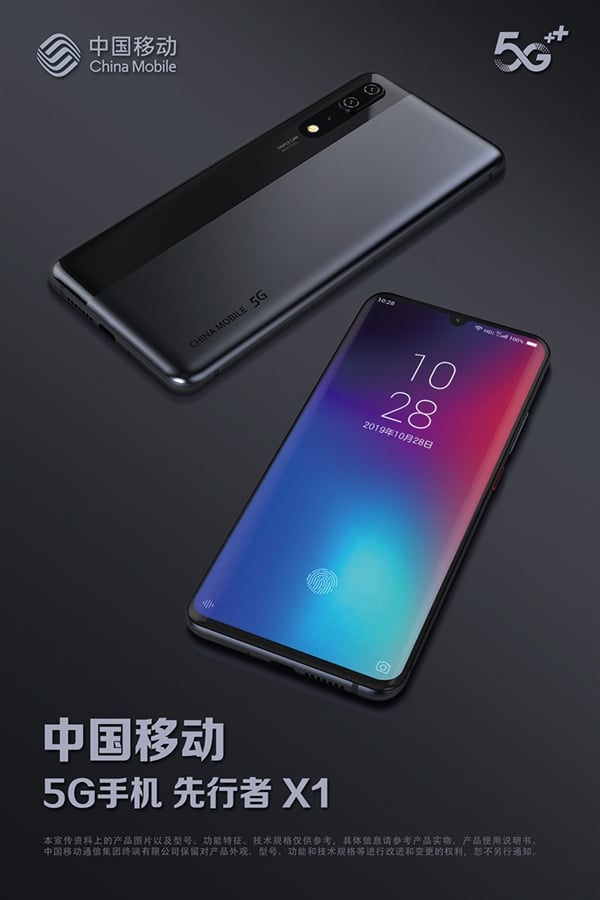
China Mobile Pioneer X1 is powered by a Qualcomm Snapdragon 855 chipset, a 6.47-inch AMOLED display with a waterdrop notch. The display supports FHD+ resolution and also houses an on-screen fingerprint scanner. Housed inside the waterdrop notch is a powerful 20MP camera.
…………………………………………………………………………………………………………………………………………………………………………………………………………………
Note: Although Samsung continues phone sales in China, last week the handset maker ceased its mobile phone production operations in China as it closed its last factory in the country, according to Reuters.
………………………………………………………………………………………………………………………………………………………………………………………………..
China’s 5G network coverage is progressing rapidly and the 5G network is increasingly equipped with a formal commercial foundation. Recently, the official statistics of the Beijing Municipal Bureau of Economics and Information Technology state that the three major network operators have completed more than 8,800 5G base stations in Beijing, covering areas along Chang’an Avenue, the World Expo, CCTV Broadcasting Center, and Shougang Park.
According to a message released by the Beijing Communications Administration, it is expected that by the end of 2019, Beijing will build more than 10,000 5G base stations. According to the current construction progress, the number of 5G base stations in Beijing is expected to reach 12,000 by the end of the year. Among the other three first-tier cities, Shanghai plans to build 10,000 5G base stations in 2019 and 20,000 5G base stations in 2020; Guangzhou proposes to complete no less than 20,000 5G base stations in 2019, and 5G will be built in 2021. The base station is 65,000; the plan for Shenzhen is to build 15,000 5G base stations by the end of 2019.
With the spread of 5G networks, innovative applications in various 5G environments are emerging and even landing. On September 25, Daxing International Airport was officially opened. Eastern Airlines, Beijing Unicom and Huawei jointly released a 5G-based smart travel integrated service system at Daxing International Airport. Under the system, the user does not need to present the ID card and the QR code as usual, and only needs face recognition to complete the travel process such as ticket purchase, check-in, check-in, security check, and boarding.
China’s government is partially subsidizing 5G deployments as we note in several paragraphs below:
- The Shenzhen city government is offering to pay operators RMB10,000 ($1,398) for every standalone 5G base station deployed, with a maximum payout of RMB150 million ($20.9 million). Its 5G plan issued last month promises support for site acquisition and subsidies for base station electricity costs. The tech-dominated Chinese city, home to Huawei, ZTE and Tencent, plans to install 15,000 5G base stations by the end of 2019 and 45,000 by next August (more on this below).
- Almost every Chinese city or provincial government has a 5G development plan. While many are light on specifics, some reveal big ambitions. For example, the government of Zhejiang, the wealthy province near Shanghai, expects to have 30,000 base stations next year. It plans to complete its 5G rollout by 2022, by which time its coverage will “lead the country.”
- The north-west province of Shanxi — not known for its advanced tech industries — has also made 5G a top priority. It has bench marked its 5G rollout against other provinces and, like Zhejiang, has set a target of 30,000 base stations by 2022. And the city is also offering subsidies for base station power costs and help in site selection.
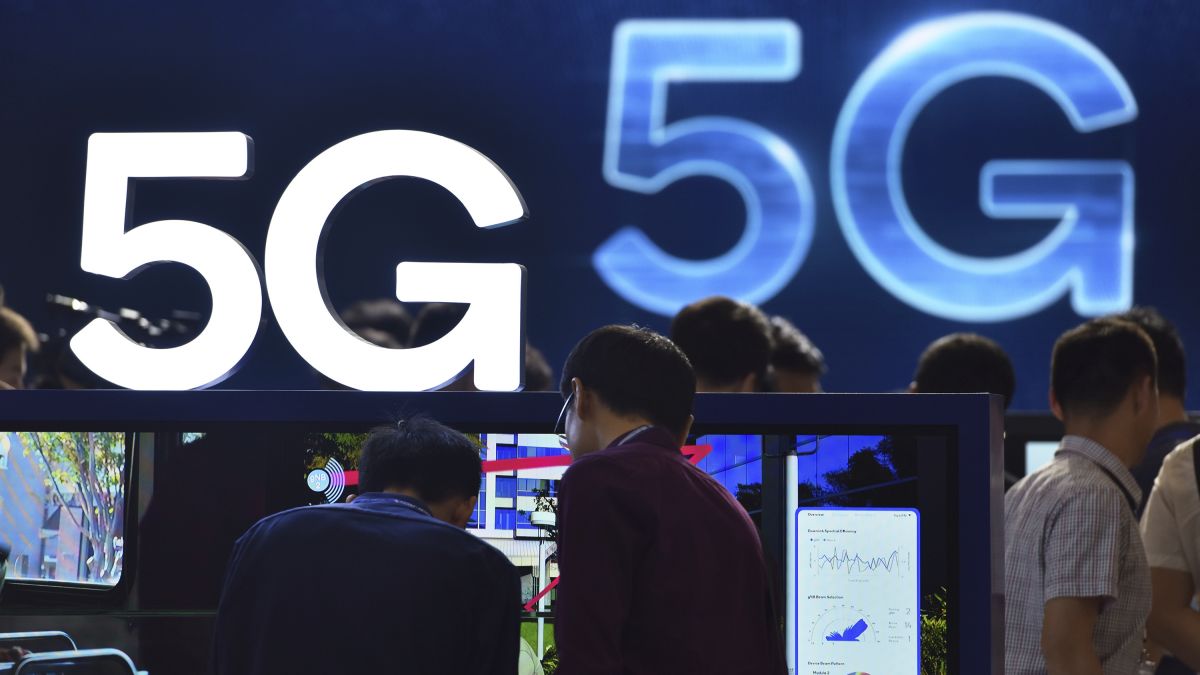
………………………………………………………………………………………………………………………………………………………………………………………………..
From an article titled, “The Real 5G Winner Could Be China,” in the October 7, 2019 print edition of Barron’s:
Multiple Wall Street analysts are getting more optimistic about China’s 5G build out. For instance, Rosenblatt Securities notes that local governments in the Asian country are providing subsidies to “speed up 5G network deployments.” As a result, Rosenblatt says, more than 300 cities in China will have 5G networks by the end of next year. Even Hall, the Goldman Sachs 5G skeptic, expects 120 million 5G smartphones to ship next year, largely because of China’s aggressive build out.
In a report this past week, Piper Jaffray analyst Harsh Kumar cited a Chinese think tank that sees China-based companies spending $411 billion on 5G networks from 2020 to 2030. Of the 600,000 5G base stations expected to be rolled out worldwide next year, Kumar says half will be deployed in China: “We expect 2020 global [5G] deployments to largely be driven by the Chinese market.”
5G may come together slowly in the U.S. market, but China is serious about winning the race.
………………………………………………………………………………………………………………………………………………………………………………………………………….
References:
https://tech.sina.com.cn/t/2019-10-06/doc-iicezzrr0343842.shtml
https://www.lightreading.com/asia-pacific/china-telcos-rack-up-9m-5g-advance-subs/d/d-id/754643?
https://www.barrons.com/articles/the-real-5g-winner-could-be-china-51570228459
https://www.wsj.com/articles/in-the-race-to-dominate-5g-china-has-an-edge-11567828888
3GPP Release 16 Update: 5G Phase 2 (including URLLC) to be completed in June 2020; Mission Critical apps extended
NOTE: This article is intended as a reference, which is especially important to debunk claims made about current pre-standard 5G deployments which are almost all based on 3GPP Release 15 “5G New Radio (NR)” for the data plane with LTE signaling and LTE mobile packet core (EPC) for Non Stand Alone (NSA) operation. 5G pundits continue to site 3GPP as the standards organization responsible for 5G which is doubly wrong because it’s not a standards body and submits its 5G/IMT 2020 proposals to ITU-R WP 5D via the latter organizations member entities. As we’ve stated many times before, ITU-R is responsible for the radio standards for IMT 2020, while ITU-T is working on the non-radio aspects of IMT 2020.
………………………………………………………………………………………………………………………………………………………………………………………………………………..
Summary:
3GPP Release 16 is a major release for the project, because it will bring the specification organization’s IMT-2020 RIT/SRIT submission (to ITU-R WP 5D) for an initial full 3GPP 5G system to its completion. Release 16 will be put in a “frozen” state in March 2020 with a targeted completion date of June 2020.
3GPP work has started on approximately 25 Release 16 studies, which cover a variety of topics: Multimedia Priority Service, Vehicle-to-everything (V2X) application layer services, 5G satellite access, Local Area Network support in 5G, wireless and wireline convergence for 5G, terminal positioning and location, communications in vertical domains and network automation and novel radio techniques. Further items being studied include security, codecs and streaming services, Local Area Network interworking, network slicing and the IoT.
Here are the new features planned for 3GPP Release 16:
Details of the features and work items under each 3GPP Release are kept in the corresponding, on-line, list of features and study items.
- Enhancement of Ultra-Reliable (UR) Low Latency Communications (URLLC)
- 5GS Enhanced support of Vertical and LAN Services
- Cellular IoT support and evolution
- Advanced V2X support
- 5G Location and Positioning Services
- UE radio capability signalling optimization
- Satellite Access in 5G
- Enablers for Network Automation Architecture for 5G
- Wireless and Wireline Convergence Enhancement
- Mission Critical, Public Warning, Railways and Maritime
- Streaming and TV
- User Identities, Authentication, multi-device
- (Network) Slicing
- Other cross-TSG Release 16 Features
- NR-related Release 16 Features
- Release 16 Features impacting both LTE and NR
- LTE-related Release 16 Features
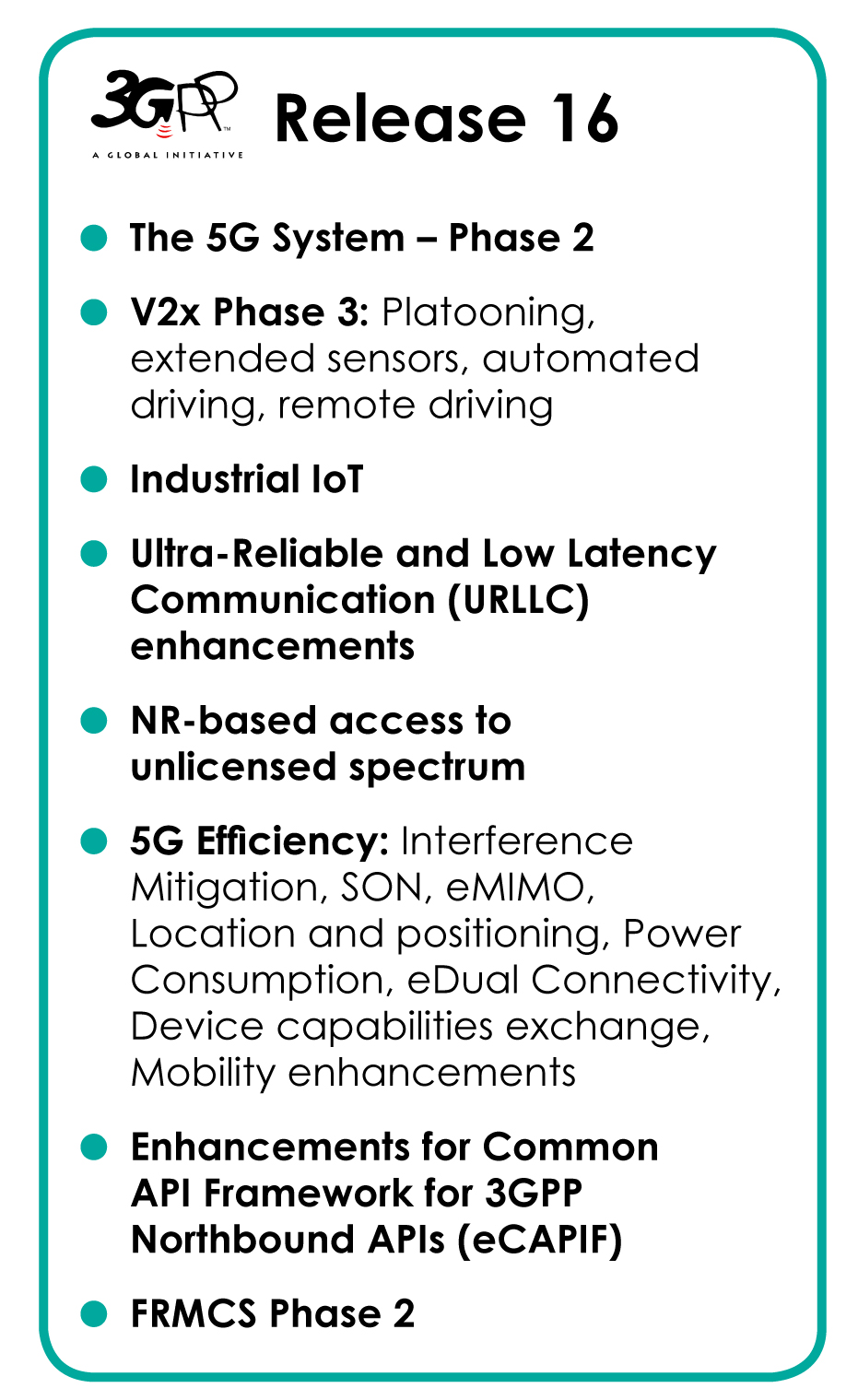
From 3GPP’s July 18, 2019 Webinar:
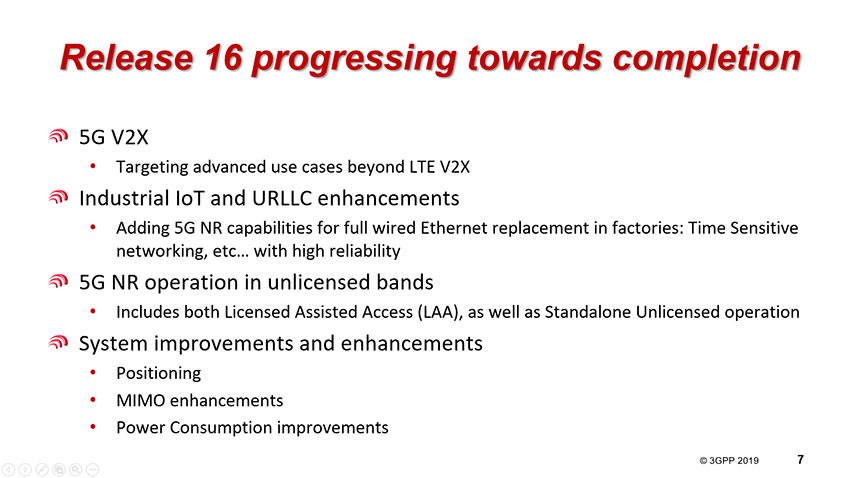
“For the (industry) verticals, there are three distinct pillars that we are focused on: Automotive, Industrial IoT and Operation in unlicensed bands. For 5G based V2X, which builds on the two iterations of the LTE-V2X, we are now adding advanced features – primarily in the area of low latency use cases.
The second focus is industrial IoT and URLLC enhancements. Factory automation, in particular, is a strong pillar for 5G going forward. We are trying to ensure that the radio side covers all of the functions that all the verticals need for factory automation. What this means in practice is that we are trying to make sure 5G NR can fully replace a wired ethernet – currently used – by adding time sensitive networking and high reliability capabilities.
The third pillar is operation in unlicensed bands. We have seen different schemes for generic 5G licensing strategies in Europe and in other parts of the World. We have seen in some countries that certain licensed bands have been allocated for vertical use cases, though that is not the case for a majority of countries. The use of unlicensed bands provides a great opportunity – where licensed spectrum is not an option. We are now focused on not only what we have with LTE, which is the licensed assisted access scheme, but also on standalone unlicensed operation – to be completed in Release 16.
Release 16 also delivers generic system improvements & enhancements, which target Mobile Broadband, but can also be used in vertical deployments – Particularly; positioning, MIMO enhancements and Power consumption improvements.”
………………………………………………………………………………………………………………………………………………………………………………………………….
Technical Reports (the result of the study phase) are also being developed on broadening the applicability of 3GPP technology to non-terrestrial radio access (initially satellites, but airborne base stations are also to be considered) and to maritime aspects (intra-ship, ship-to-shore and ship-to-ship). Work also progresses on new PMR functionality for LTE, enhancing the railway-oriented services originally developed using GSM radio technology that is now nearing end of life.
As part of Release 16, Mission Critical (MC) services will be extended to address a wider business sector than the initial rather narrow public security and civil defense services for which they had originally been developed. If the same or similar standards can be used for commercial applications (from taxi dispatching to railway traffic management, and other vertical sector scenarios currently being investigated), this would bring enhanced reliability to those MC services through wider deployment, and reduced deployment costs due to economies of scale – to the benefit of all users.
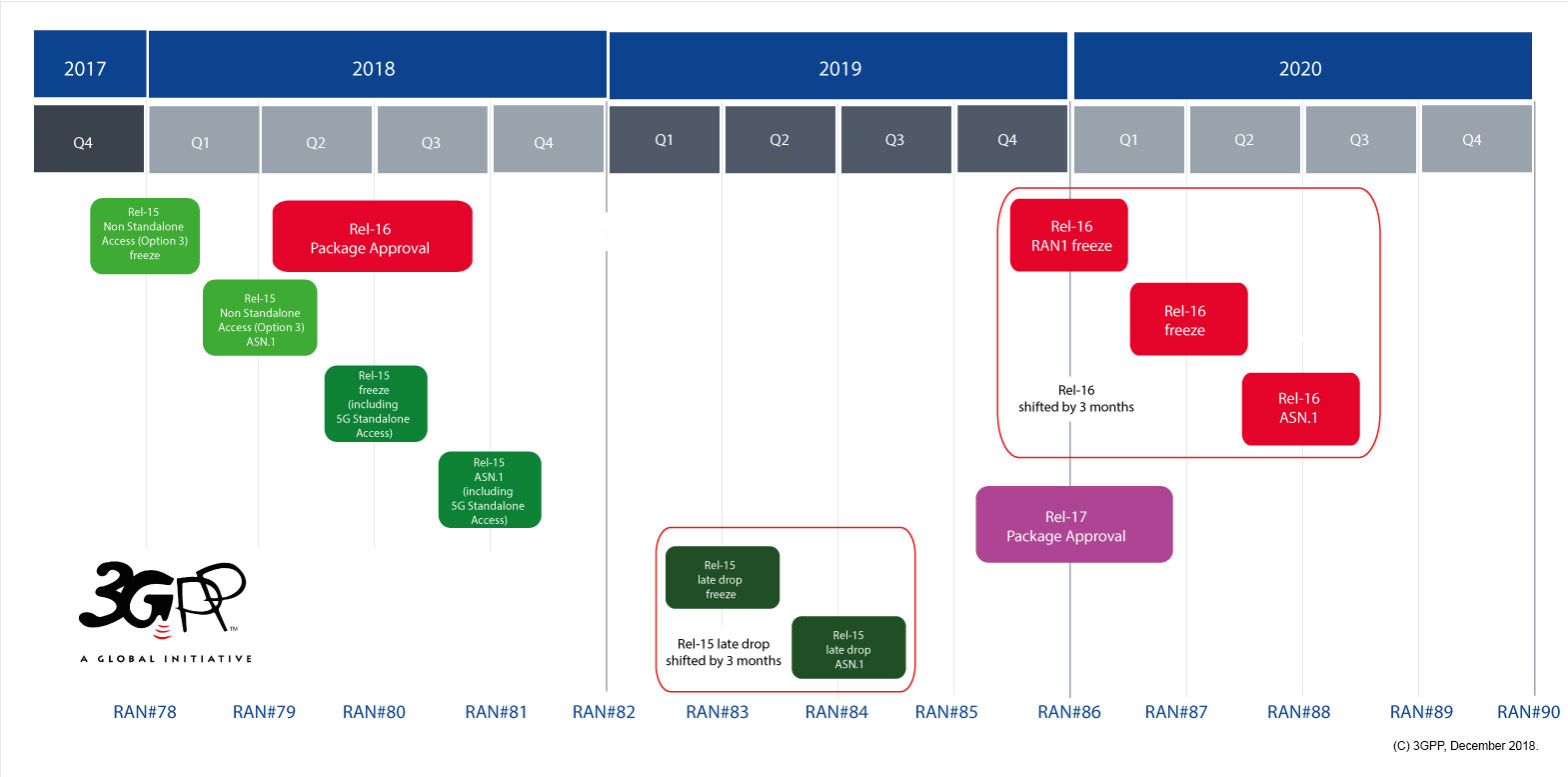
IMT-2020 – Final submission
- Calibration for self evaluation
- Prepare and finalize initial description template information that is to be submitted to ITU-R WP 5D#29.
Step 2: From early 2018 to Sep 2018, targeting “update & self eval” submission in Sep 2018
- Performance evaluation against eMBB, mMTC and URLLC requirements and test environments for NR and LTE features.
- Update description template and prepare compliance template according to self evaluation results.
- Provide description template, compliance template, and self evaluation results based on Rel-15 in Sep 2018.
Step 3: From Sep 2018 to June 2019, targeting “Final” submission in June 2019
- Performance evaluation update by taking into account Rel-16 updates in addition to Rel-15
- Update description template and compliance template to take into account Rel-16 updates in addition to Rel-15
- Provide description template, compliance template, and self evaluation results based on Rel-15 and Rel-16 in June 2019.
Some Background on Release 16
- See the full Release 16 Description – TR21.916 (Available at Release freeze)
- RAN Rel-16 progress and Rel-17 potential work areas (July 18, 2019)
- Early progress on Rel-16 bands for 5G (April 2, 2019)
- “Working towards full 5G in Rel-16”…See 3GPP webinar presentation (July 3, 2019)
- Preparing the ground for IMT-2020
- SA1 completes its study into 5G requirements
……………………………………………………………………………………………………………………………………………..
References:
https://www.3gpp.org/release-16
https://www.3gpp.org/news-events/2058-ran-rel-16-progress-and-rel-17-potential-work-areas
…………………………………………………………………………………………………………………………………………………………………………………………………….
Addendum (December 14, 2020):
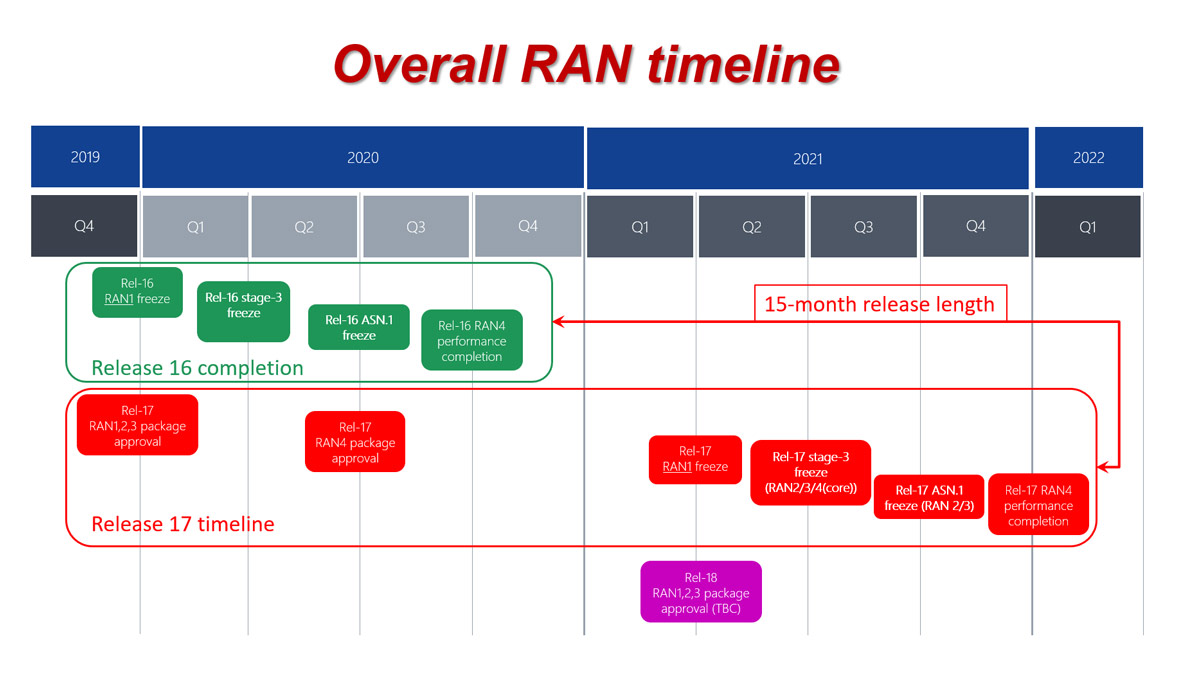
https://www.3gpp.org/news-events/2098-5g-in-release-17-%E2%80%93-strong-radio-evolution
Massive MIMO Deployments in India: Bharti Airtel vs. Vodafone Idea?
by Danish Khan (edited and augmented by Alan J Weissberger)
The deployment of massive MIMO [1] technology has led to a series of claims and counter claims between India wireless network operators Vodafone Idea Ltd. (VIL) and Bharti Airtel. Both privately held telcos claim that they lead in terms of the deployment size of this pre-5G technology.
Note 1. Massive multiple-input, multiple-output, or massive MIMO, is an extension of MIMO, which essentially groups together antennas at the transmitter and receiver to provide better throughput and better spectrum efficiency.
Moving from MIMO to massive MIMO, according to IEEE, involves making “a clean break with current practice through the use of a large excess of service antennas over active terminals and time-division duplex operation. Extra antennas help by focusing energy into ever smaller regions of space to bring huge improvements in throughput and radiated energy efficiency.”
Many different configurations and deployment scenarios for the actual antenna arrays used by a massive MIMO system can be envisioned (see Fig. 1). Each antenna unit would be small and active, preferably fed via an optical or electric digital bus.
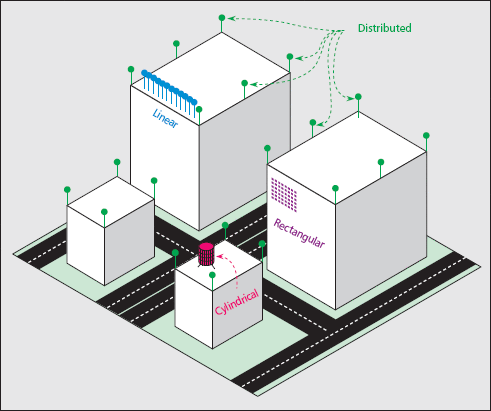
Figure 1. Some possible antenna configurations and deployment scenarios for a massive MIMO base station.
……………………………………………………………………………………………………………………………………………………………………………………………………..
In a statement, Huawei said that Bharti Airtel has deployed more than 100 hops of enhanced MIMO microwave link based on the latest MIMO technology developed by the Chinese gear maker. The deployment, Huawei said, will deliver 1Gbps capacity over a single 28 Mhz spectrum, improving the backhaul capacity by four times.
“Bharti implements the largest-scale MIMO deployment around the world,” Huawei said in the statement. Airtel had made its first commercial deployment of massive MIMO in September 2017.
Bharti Airtel today (Sept 26, 2017) announced the deployment of India’s first state-of-the-art Massive Multiple-Input Multiple-Output (MIMO) technology which is a key enabler for 5G networks. As one of the few commercial deployment of Massive MIMO globally, the deployment puts India on the world map of technology advancement and digital revolution. Airtel is starting with the first round of deployment in Bangalore & Kolkata and will expand to other parts of the country.
Deployed as part of Airtel’s ongoing network transformation program, Project Leap, the Massive MIMO technology will expand existing network capacity by five to seven times using the existing spectrum, thereby improving spectral efficiency. Customers will now be able to experience two to three times superfast speeds on the existing 4G network. Data speeds will now also be seamless, offering enhanced user experience even indoors, in crowded places and high rise buildings. It would enable multiple users and multiple devices to work simultaneously without facing any congestion or experience issues especially at hotspot locations.
But in an interview with ET last week, Vodafone Idea chief technology officer, Vishant Vora had claimed that it was the leader in MIMO deployments in India. “We have deployed over 10,000 massive MIMOs in India. This is the largest deployment of massive MIMOs in India and neither of my two competitors has that. They are 100-200 and we are at 10,000 plus. This is the largest deployment outside China and in the world,” Vora said.
Vodafone Idea told ET this past March:
Vodafone Idea has deployed more than 5000 massive MIMO, small cells and TDD sites across Church gate, Prabhadevi, Pali hill, Lokhandwala, Versova, Andheri, Jogeshwari, Bandra and Dadar among other regions. The telco has also installed over 1900 indoor coverage solutions for high rises and commercial places.
“With meticulous pre-merger planning and rigorous post-merger execution, we have ensured that our customers remain confidently connected and enjoy uninterrupted services even as we integrate and optimize our network in a phased manner across circles,” said Vishant Vora, CTO, Vodafone Idea.
………………………………………………………………………………………………………………………………………………………………………………………………
Huawei is also providing 4G equipment and massive MIMO technology to Vodafone Idea in seven circles. Huawei didn’t provide additional information.
The MIMO technology achieves four times capacity with same spectrum, allowing a telecom operator to build a 5G-ready transport network without investment in additional spectrum . MIMO deployment also allows telcos to address the capacity-related network issues in urban areas in India, besides deploying new sites to provide coverage in rural parts.
Mukesh Ambani-led Reliance Jio has also started to deploy massive MIMO technology in some of the metro cities that are seeing huge traffic growth resulting in bad data speed experience.
………………………………………………………………………………………………………………………………………………………………………………………………
References:
Far EasTone Telecommunications 5G Indoor Trials; Chunghwa Telecom 5G Field Trial for Driverless Cars
The telecom hopes the trials help companies transit to 5G technology more smoothly, vice president Philip Tseng told reporters in Taipei.
Far EasTone Telecommunications Co Ltd of Taiwan said yesterday that it plans to set up an indoor 5G trial field next month at Neihu Technology Park for 100 enterprises or research organizations. The announcement came a day after the telecom won the first approval to install a 5G-based Proof of Business network. The Taiwan National Telecommunications Commission has approved six 5G proof-of-concept trials and is still reviewing other applications, it said, adding that it welcomes more applications to explore business opportunities or business models on 5G networks. Telecoms that win 5G spectrum licenses are expected to launch commercial 5G services in July next year (2020) at the earliest, the commission said.
The telecom said it plans to offer the trials in collaboration with Ericsson Taiwan at the Neihu Sports Center on a commercial 5G network using the 3.5 gigahertz band. As part of the trials, Far EasTone is to supply free 5G SIM cards, routers and a 5G applications enablement platform (undefined?), allowing firms to test Internet of Things (IoT) business opportunities from this month to December 2019. The average download speed of the 5G network will be at least 10 times faster than a 4G LTE network, the company said.

“We hope the trials help upstream and downstream companies transit to 5G technology more smoothly,” Far EasTone vice president Philip Tseng told reporters on the sidelines of a news conference in Taipei. The telecom is teaming up with Taipei’s Smart City Project Management Office, Department of Information Technology and Department of Economic Development, as well as the Taiwan IOT Technology and Industry Association to launch the 5G trials.
Notebook computer maker Compal Electronics Inc and smartphone maker HTC Corp are to provide the 5G endpoints to be tested, the telecom said.
……………………………………………………………………………………………………………………………………………………………………………………………………….
Ericsson — Taiwan to beat Europe in 5G deployments:
In August, Ericsson said it expects Taiwan to ramp up 5G services faster than Europe once the nation’s 5G spectrum is auctioned, thanks to its strong position in the communications components manufacturing supply chain.
“Taiwan has an industry that manufactures a lot of components. That is not the case in many countries in Europe or elsewhere,” Nassif told a media briefing in Taipei. “Here you have the possibility of creating all kinds of ecosystems. You have a better chance of rapidly achieving scale.”
“Taiwan is getting ready and I have a good feeling that 5G will be here in Taiwan next year, thanks to the many initiatives that have been planned by local telecoms even before December’s 5G spectrum auction,” Nassif said.
Taiwan’s National Communications Commission plans to auction 2,790 megahertz (MHz) of bandwidth for 5G services, including 270MHz in the 3.5 gigahertz (GHz) band, 2,500MHz in the 28GHz band and 20MHz in the 1,800MHz band. The commission has not yet set the floor price.
Taiwan has shown a readiness to embrace 5G services, given its high data usage — 20 gigabytes per month, one of the highest in the world — and its tech-savvy mobile users, said Peter Fung, head of networks for Ericsson in Taiwan, Hong Kong and Macau.
Ericsson, which has secured 47 contracts from telecoms worldwide, is collaborating with Chunghwa Telecom Co (中華電信), Far EasTone Telecommunications Co (遠傳電信) and Asia Pacific Telecom Co (亞太電信) in the deployment of their 5G networks.
……………………………………………………………………………………………………………………………………………………………………………………………………….
About Far EasTone Telecommunications:
Far EasTone Telecommunications (FET) is a leading company in Taiwan which provides telecommunications and digital application services. Since its establishment in 1997, FET has strived to close the gap between people to achieve the objective of “Closing the distance”. As the 5G era approaches, FET has set its sights beyond telecommunications and has reinterpreted the brand statement in 2019, setting a new milestone with ” For Every Thought, We Go Further”. FET’s aim is, through Big Data, AI, IoT and other digital applications, to not only bring people closer together in mind, also to reduce the gap between people and new technology.
Since its establishment in 1997, FET has continued to introduce new products and services utilizing access technologies, including 2G, 3G, 4G and WiFi. As the popularity of smart devices grows rapidly, FET is investing heavily in the improvement of internet infrastructure, actively enhancing the speed and quality of mobile networks, upgrading base stations, and expanding the channel range.
FET has collaborated with the telecom equipment giant Ericsson to establish the first 5G Lab in Taiwan. In 2018, FET announced the establishment of the “FET 5G Pioneer Team,” the first in Taiwan to drive development of 5G connected vehicle technologies and ecosystem in Taiwan. In the future, it will further take on the challenge of reaching the fastest network speed with 4-band dual technology. We will also continue to develop IoT applications and polish our mobile services to become the preferred partner in the digital life and pave a solid path forward to the future of 5G roll-out.
……………………………………………………………………………………………………………………………………………………………………………………………………….
References:
http://www.taipeitimes.com/News/biz/archives/2019/10/05/2003723392
http://www.taipeitimes.com/News/biz/archives/2019/08/13/2003720368
https://www.fetnet.net/corporate/en/
https://en.wikipedia.org/wiki/National_Communications_Commission
……………………………………………………………………………………………………………………………………………………………………………………………………………
In a related development — Chunghwa Telecom holds 5G field trial for driverless cars:
Chunghwa Telecom yesterday (October 3, 2019) conducted a 5G spectrum-based field trial for autonomous vehicles at a lab in New Taipei City’s Banciao District to demonstrate vehicle-to-infrastructure technology developed by a subsidiary. The telecom expects to provide more autonomous vehicle tests and trials using 5G networks at its lab in the future.
“Our aim is to help grow this 5G value chain ranging from chips and small cell stations to all kinds of applications,” Chunghwa Telecom chairman Hsieh Chi-mau told reporters on the sidelines of the field trial.
The company focuses on the delivery of real-time information, such as traffic data to vehicles using high-speed and low-latency 5G technology, while Kingwaytek Technology Co (勤崴), a 26 percent held subsidiary, is helping to develop autonomous driving systems, particularly for shuttle buses, Hsieh said. Kingwaytek is a supplier of high-definition (HD) electronic maps and vehicle navigation systems.
“We are developing a decisionmaking system for self-driving vehicles and a traffic prediction system, which will be combined with our HD electronic maps to complete our self-driving solution,” Kingwaytek chairman Alfred Ko said. Kingwaytek plans to conduct a series of self-driving field trials next year in collaboration with Automotive Research and Testing Center via a sandbox program in Changhua County, Ko said.
The trial, if successful, would pave the way for the company to sell its self-driving solutions overseas in the next two to three years, injecting new revenue growth momentum into the business, he said. Southeast Asian nations would be ideal markets, as Chunghwa Telecom’s strength in the region could provide leverage, he said.
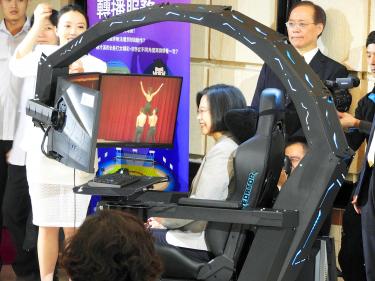
President Tsai Ing-wen, sitting, tries out 5G-enabled technology at a news conference in New Taipei City yesterday. Photo: Lai Hsiao-tung, Taipei Times
…………………………………………………………………………………………………………………………………………………………………………………………………………………………………………………………………………………….
Kingwaytek operates one autonomous vehicle trial field in Changhua County and another in Taoyuan’s Hutoushan.
Chungwha Telecom and Taiwan Mobile Co both said separately that they have submitted their applications to bid for 5G bandwidth and are prepared to substantially invest in 5G network deployment. Asked if Taiwan Mobile still aims to secure 100 megahertz of bandwidth at the auction, Taiwan Mobile president Jamie Lin (林之晨) said: “Only for a reasonable price.”
“Taiwan Mobile will make 5G [services] available in the second half of next year,” Lin said.
The telecom is in talks with multiple agencies about launching 5G trial fields, he said, adding that the company has one trial field in the baseball stadium in New Taipei City’s Sinjhuang District.
Reference:
http://www.taipeitimes.com/News/biz/archives/2019/10/04/2003723337
Altice Portugal Interview: 10Gbps services to build the ultra-connected future
Interview of Alexandre Fonseca, CEO of Altice Portugal by Chris Kelly of Total Telecom
Portugal is one of the most ambitious nations in Europe with regards to FTTH penetration targets. How are you progressing with this and what challenges are you facing?
Due to the work developed by Altice Portugal in the last years, Portugal is today an international case study with proven experience in several countries, such as USA, France, Russia, New Zealand, India, the UK or Brazil, regarding FTTH projects. Altice Portugal presents one of the best and largest next generation network infrastructures, reaching 4.8 million of households in Optical Fiber, moving closer to the 2020 target of 5.3 million. This brings Portugal as one of the first countries in Europe to reach nearly 100% of the population. We deployed FTTH throughout the country, both in urban and rural areas, boosting the economic development and digital inclusion.
Despite the significant investment performed, it is important to underline that Portugal still awaits for a 5G Roadmap, regarding the availability of frequencies and licenses in order to launch 5G commercial networks. The country needs a clear strategy and vision for 5G, to continue to take the lead, as in previous technology generations of telecommunications.
Does Europe need to agree a single unified switch off date for its existing copper networks?
The optical fiber infrastructure is more robust and more reliable in technological terms, being more immune to adverse weather conditions, thefts or vandalism, with a much lower failure rate than the copper networks and, consequently having better operational responsiveness, besides the significantly better performance it brings to Services.
The replacement of copper by optical fiber, being a natural evolution both for technological and business reasons, depends on each country´s dynamics, not being determinant the existence of a single date for this to happen. However, this change is essential for Portugal to remain at the forefront of Europe and is also sustained by the fact that copper networks are obsolete and unable to support new innovative services. Optical fiber is undoubtedly the technology that makes it possible to offer a set of new future proof services and features that copper no longer supports. Altice Portugal has started a pilot project in parishes of six Portuguese municipalities that were 100% covered by fiber. The project contributes to digital inclusion growth, broadening access to advanced services, promoting economic development and modernization and of course, copper decommissioning.
With the emergence of new technologies, what scope is there for delivering 10Gbps services?
10Gbps services will help us build the ultra-connected future we all require. The predicted increase in number of devices and data volumes requires intelligent networks with a new level of speed and capacity. Homes with 50-100 connected devices will drive unprecedented demand. Now, life-changing technologies for connected health, augmented and virtual reality, will deliver incredible experiences and require significant speed, low latency and high capacity. 10Gbs services are becoming more crucial for the enterprise market, namely for data center access, data center interconnection and trunk circuits to collect high bandwidth traffic from data, video & voice under virtual private networks.
The launch of new technologies is not a goal in itself – what really matters is the experience provided by services and the added value for customers. That’s the world we are building, one in which everything is connected everywhere.
What role will fibre play in underpinning 5G mobile network rollout in Portugal?
5G technology is not simply about faster internet connections, it will bring huge changes in network architecture and services. It will enable a step change of ultrafast broadband connections, boosted by low latency, ultra-reliable communications, massive machine-type communications and slicing capabilities. The major characteristics introduced by 5G can be summarized in the Throughput, Latency and Density of the connections.
Fibre optics will be a key enabler of 5G, especially as a backhauling technology, once it provides the extremely high speeds, capacity and low latency required to connect each 5G station. FTTH rollout is a key differentiator for providing nationwide 5G coverage and Altice Portugal is ready and prepared for 5G rollout, with over 95% of its mobile stations already connected through fiber. Besides the FTTH deployment, Altice Portugal performed the first 5G live demonstration in a commercial network environment with pre-commercial terminals in July 2018 and the first live television broadcast in Portugal using the 5G network in real environment in June 2019.
How much of a game changer is 5G going to be in regard to IoT uptake?
5G will have a fundamental role boosting the era of smart connectivity, capable of taking advantage of unreachable response times with today’s technologies, to grant new scenarios of digital interactivity on multiple devices. 5G will reinforce applications for B2B, B2C and B2B2C markets, especially in areas as IoT, or IIoT, industrial automation and critical services, especially in Healthcare, Smart Grids, Smart cities, Industry 4.0 or Autonomous Vehicles, being a relevant factor in the development of the economy of each country and the world in general.
Altice Portugal has been exploring, for a long time, the opportunities related to IoT. In 2018 we opened the Golabs.IoT, a live technology Lab that generates synergies between developers, universities, startups and industry players.
Altice Labs, our R&D unit, also has projects in 5G and IoT landscape, with several national and international institutions, including Portuguese municipalities, such as the city of Aveiro, with 5G being available for the development of early adoption services for cities or citizens, on an open community enviroment.
What predictions do you have for the industry over the next 12-18 months?
Companies and businesses are undergoing a very important digital transformation process…the telecommunications sector is amongst the ones suffering the most, but also well positioned to have a leading role on this transformation.
We will surely see a transition´s process from automation to true digitalization. Digitalization has accelerated information production and distribution, innovation and process disruption, together with the integration of the physical and virtual worlds and the use of real time data. All this has a huge impact on organizational structures, business models, logistics operations and products and services themselves.
But this is not just a business-level transformation. This represents a social transformation, with new ways for people to relate themselves, to learn, to work and providing all equal access to technologies.
The process of digital transformation and technological development requires us to always innovate and our effort and commitment must be dedicated to always bring more and better services to the Portuguese.
We believe that the Smart Living concept will bring forward a set of new and combined technologies, for personal and business usage that will improve our live, generate the opportunity to save time and therefore improving our work life balance. Technology will continue to improve people’s life’s and business productivity, providing quality time to individuals, families and communities, turning content and experience the most relevant killers Apps in this new technology generation.
https://www.totaltele.com/503944/Altice-Portugal-10Gbps-services-will-help-us-build-the-ultra-connected-future-we-all-require
…………………………………………………………………………………………………………………………………………………………………………
Backgrounder:
Altice Portugal is the largest telecommunications service provider in Portugal. Since June 2, 2015, the company is a wholly owned subsidiary of Altice Group, a multinational cable and telecommunications company with a presence in France, Israel, Belgium, Luxembourg, Portugal, French West Indies/Indian Ocean Area, the Dominican Republic (“Overseas Territories”), Switzerland, and the United States. Its assets in Portugal were sold to Altice in 2015 per request of, Oi SA,[4] to reduce debt. The African assets were mostly sold for the same reason. Portugal Telecom, SGPS SA was split in separate companies: PT Portugal (now Altice Portugal) and Pharol (formerly PT SGPS), which owns a 27,5% stake in Oi.
The company owns MEO, the largest landline operator in Portugal. Its operating brands include MEO, a quadruple play service provider and SAPO, an ISP and producer of web content. Portugal Telecom also owns Altice Labs (formerly known as PT Inovação), an IT services and research and development company; PT Contact, focused in the business of managing contact centers.

Altice Portugal Building in São Jorge de Arroios
Reference:


